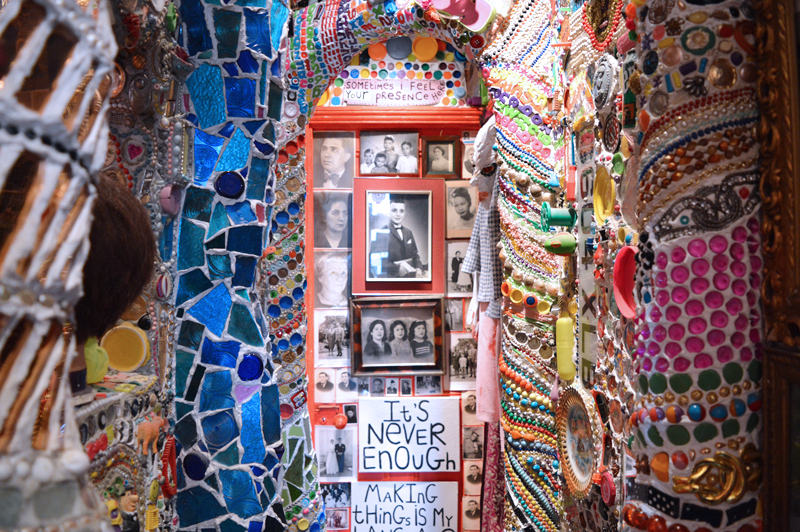To East Dulwich to visit Stephen Wright’s House of Dreams – I’d heard about this extraordinary insider-outsider artwork a few years ago, but it was the looming end of the stamp duty holiday called by Rishi Sunak in order to prop up that Ponzi scheme also known as ‘the British economy’ that finally got me on my bike. After all, while almost every homeowner in the country looks to their property as an investment, Stephen regards his as not just a repository of cultural capital, but a sort of accumulator of psychic energy.
Stephen began working transforming the house with his late partner, Donald, who died in the noughties – as did Stephen’s parents, Madge and Charlie. After these bereavements, the focus for the project became the embedding of memories into its extraordinary and ever-evolving mucilage. And ‘mucilage’ is really the only word that does justice to what Stephen’s achieved: for while the house is a perfectly ordinary late-Victorian terrace at root, superficially it’s a riot of colours and objects: a dense coating of thinginess that begins with a floor covered in mosaics and other inlays, then spreads up into stalagmite-like sculptural forms, wall paintings, collages and other assemblages of all manners of stuff, from old shoes and discarded bottles of bleach, to mannequins, puppets, and myriad dolls in many different states of dishabille and disarticulation.
Wherever the eye alights there is something unexpected: an old compact floppy disc mortared into a wall, or a watering can glued to a giant doll’s head. And where there aren’t things – there are slogans, legends and apercus, all in Stephen’s own distinctively naïve script, some directly referring to family memories with a place name a date, and an evocation of the weather. There’s a portrait of Stephen’s parents in the front room, and to me he hymned his happy childhood spent on a smallholding outside Nantwich. In the autumn the family kept itself on the proceeds of the fruit they grew – the rest of the year Charlie worked on the railways and Madge as a cleaner. An only child, Stephen got used to making things to keep himself company.
So, it’s the practice of making quite as much as what’s made that’s the genius loci here. A textile designer originally, Stephen says he’s far too well trained to be a proper outsider artist: ‘Although I’ve been trying to forget all I’ve ever learnt for years now!’ He doesn’t seem to have managed it that well – the mosaic work, in particular, is highly accomplished – but if his technique can be a bit professional, his ideation is beautifully and eccentrically amateurish. Drawn by some mysterious force to visit Oaxaca in Mexico, Stephen found the house where he was born in a previous lifetime: it was this transcendent homecoming that led to the founding of the House of Dreams – together with Stephen’s discovery of outsider artists such as Facteur Cheval and Bodan Litnianski.
Mexico remains very important to Stephen, as does India – and perambulating the anfractuous passageways through this phantasmagorical environment it’s easy to see why: both Mexico and India are worlds entire in their own right – cultures in which everything you see about you is self-referential: an infinite regression of monads, inscribed the minutest of which there is nonetheless the legend: MADE IN INDIA or Mexico. The House of Dreams is the same: absolutely suffused in itself and Stephen and those he knows – as well as its visitors: “People bring things – and the things here evoke their own memories.’”
Working up this curious and ever-evolving palimpsest takes time and effort – and the practice is as much the sourcing of the stuff as its arrangement: ‘I just put it where it seems to go,’ Stephen told me, standing beside a sculpture of a small furry quadruped put together out of wood, wool, and one of his late mother’s girdles. Before the pandemic he went abroad regularly, and found much of what he needed in France: for a while we waxed lyrical about a shop we both know in Montmartre, Tombé du camion (‘Fallen off the back of a lorry’) that sells discontinued stock of all kinds, including glass eyes, matchboxes, and of course legions of pink and poseable dolls.
Stephen’s current partner, Michael, pitched up – and we sat in the garden chatting for a while. Michael does the shrubbery and Stephen the flowers and the overall feel is a sort of mutant cross between Gertrude Jekyll’s garden designs and a JG Ballard post-apocalyptic dystopia. We discussed the oddity of all these artists creating these singular environments and Michael said: “I always think of the beginning of Close Encounters of the Third Kind where these people all over the world are driven, without knowing why, to mould the same sort of strange mounds without knowing why…” which seems like as good a definition of a multi-culture as any.
Warning: Illegal string offset 'link_id' in /mnt/storage/stage/www/wp-includes/bookmark.php on line 357
Notice: Trying to get property 'link_id' of non-object in /mnt/storage/stage/www/wp-includes/bookmark.php on line 37








